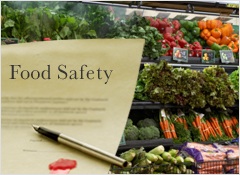Everyone in the food industry is rapidly becoming aware of the new sheriff in town.
The FDA has vastly more authority than it did only a few months ago and it’s having an impact on how companies are looking at their sanitation scheduling and standards. (see the Food Safety Modernization Act).
I have worked at a few of these companies recently and they compare the new inspection standards to those once reserved for those subject to the USDA.
In short – the bar has been raised. Companies have the following options: Get this right or get shut down.
Companies have the following options: Get this right or get shut down.
One of the keys to success under this new environment is the scheduling of your sanitation periods and crews. There are two basic scenarios (with several smaller ones that will not be covered here).
Scenario #1: You have plenty of capacity and plan to continue sanitizing on the weekends. This is a good idea and usually works when you have a dedicated sanitation crew that works full weekends. In the world of shift scheduling, we call this crew a Weekend Warrior Crew. There are two reasons this works. First of all since most sanitation takes place on the weekends, you can have a crew that is sized appropriately to handle that additional work. Secondly, while you may be able to run more than five days between sanitation periods, you probably don’t want to. The reason for this is that this may cause sanitation to take place during the week which could then push production into the weekend (overtime!).
Scenario #2: You are out of capacity and are currently running 24/7. When this occurs, you want to run as long as you can before stopping to sanitize. This also means that sanitation could occur at any time and therefore, you must be staffed for that. This can be handled in two different ways. The first way would be to increase the number of sanitation specialists you have. This will provide broader coverage but create significant idle time when no cleaning is taking place. The second way is to train production crews to help sanitize. This means more training as well as some discipline since most production people don’t like to change roles.
Finally, there is the methodology to get from whatever you are doing now to however you want to be doing things in the future. You must have a clear idea of what you need. How many production people do you need to stay over and how much time will it save/cost to use more/less? What is the opportunity cost of downtime lost to sanitation? How will you bring the workforce onboard? Remember, this could be a big change for them, and people don’t like change.
Please contact us if you’d like to discuss how we can help. Call or text us today at (415) 763-5005.
